 |
 |
Our enthusiastic and extremely knowledgeable perennials team is here to answer your questions and help you choose the best perennials for your situation. There’s always something in bloom for sun, shade, butterflies, birds or deer resistance as well as a variety of bulbs for your space.
Stroll through our time-tested favorites and introduce yourself to the newest varieties. We garden with perennials too; we love them and it shows!
|
35 found, showing page 1 of 3
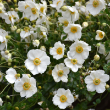
Plant Height: 3 feet
Flower Height: 4 feet
Spread: 24 inches
Sunlight: full sun partial shade
Hardiness Zone: 4a
Other Names: Japanese Anemone Description:
Elegant white buttercup flowers rise high above dark green foliage; windflowers are perfect for naturalizing, swaying gently in the wind and blooming at the end of the season; lovely when massed along borders or in containers
Ornamental Features
Honorine Jobert Anemone is smothered in stunning white buttercup flowers with yellow eyes at the ends of the stems from late summer to early fall. The flowers are excellent for cutting. Its lobed leaves remain dark green in color throughout the season.
Landscape Attributes:
Honorine Jobert Anemone is a dense herbaceous perennial with an upright spreading habit of growth. Its relatively fine texture sets it apart from other garden plants with less refined foliage.
This is a relatively low maintenance plant, and is best cleaned up in early spring before it resumes active growth for the season. It is a good choice for attracting bees and butterflies to your yard. It has no significant negative characteristics.
Honorine Jobert Anemone is recommended for the following landscape applications:
- Mass Planting
- General Garden Use
- Container Planting
Planting & Growing
Honorine Jobert Anemone will grow to be about 3 feet tall at maturity extending to 4 feet tall with the flowers, with a spread of 24 inches. Its foliage tends to remain dense right to the ground, not requiring facer plants in front. It grows at a medium rate, and under ideal conditions can be expected to live for approximately 10 years. As an herbaceous perennial, this plant will usually die back to the crown each winter, and will regrow from the base each spring. Be careful not to disturb the crown in late winter when it may not be readily seen!
This plant does best in full sun to partial shade. It prefers to grow in average to moist conditions, and shouldn't be allowed to dry out. It is not particular as to soil type or pH. It is somewhat tolerant of urban pollution. This particular variety is an interspecific hybrid. It can be propagated by division; however, as a cultivated variety, be aware that it may be subject to certain restrictions or prohibitions on propagation.
Honorine Jobert Anemone is a fine choice for the garden, but it is also a good selection for planting in outdoor pots and containers. With its upright habit of growth, it is best suited for use as a 'thriller' in the 'spiller-thriller-filler' container combination; plant it near the center of the pot, surrounded by smaller plants and those that spill over the edges. It is even sizeable enough that it can be grown alone in a suitable container. Note that when growing plants in outdoor containers and baskets, they may require more frequent waterings than they would in the yard or garden.
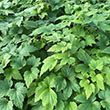
Prolific bloomer with large light pink semi-double blooms and compact habit. Prefers moist soil. USDA 5-9
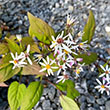
Height: 30 inches
Spread: 30 inches
Sunlight: partial shade full shade
Hardiness Zone: 3a
Other Names: syn. Aster divaricatus, White Star Aster
Description:
A profusion of airy white flowers with gold to red eyes, over a mound of small green leaves; thrives in shade and tolerates dry conditions; water the root zone instead of from the top to reduce fungal disease; water regularly to encourage more blooms
Ornamental Features:
White Wood Aster has masses of beautiful white flat-top daisy flowers with gold eyes at the ends of the stems from mid to late summer, which are most effective when planted in groupings. Its small heart-shaped leaves remain light green in color throughout the season.
Landscape Attributes:
White Wood Aster is an herbaceous perennial with an upright spreading habit of growth. It brings an extremely fine and delicate texture to the garden composition and should be used to full effect.
This is a relatively low maintenance plant, and is best cleaned up in early spring before it resumes active growth for the season. It is a good choice for attracting butterflies to your yard, but is not particularly attractive to deer who tend to leave it alone in favor of tastier treats. Gardeners should be aware of the following characteristic(s) that may warrant special consideration: Disease
White Wood Aster is recommended for the following landscape applications:
- Mass Planting
- Rock/Alpine Gardens
- Border Edging
- General Garden Use
- Groundcover
- Naturalizing And Woodland Gardens
- Container Planting
Planting & Growing:
White Wood Aster will grow to be about 30 inches tall at maturity, with a spread of 30 inches. Its foliage tends to remain dense right to the ground, not requiring facer plants in front. It grows at a medium rate, and under ideal conditions can be expected to live for approximately 4 years. As an herbaceous perennial, this plant will usually die back to the crown each winter, and will regrow from the base each spring. Be careful not to disturb the crown in late winter when it may not be readily seen!
This plant does best in partial shade to shade. It prefers to grow in average to dry locations, and dislikes excessive moisture. It is considered to be drought-tolerant, and thus makes an ideal choice for a low-water garden or xeriscape application. This plant should not require much in the way of fertilizing once established, although it may appreciate a shot of general-purpose fertilizer from time to time early in the growing season. It is not particular as to soil type or pH. It is somewhat tolerant of urban pollution. This species is native to parts of North America. It can be propagated by division.
White Wood Aster is a fine choice for the garden, but it is also a good selection for planting in outdoor pots and containers. With its upright habit of growth, it is best suited for use as a 'thriller' in the 'spiller-thriller-filler' container combination; plant it near the center of the pot, surrounded by smaller plants and those that spill over the edges. It is even sizeable enough that it can be grown alone in a suitable container. Note that when growing plants in outdoor containers and baskets, they may require more frequent waterings than they would in the yard or garden.
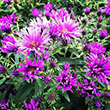
This compact, densely branched perennial is perfect for today's gardener. Requiring little work or care, it resists disease and adapts to a wide range of growing conditions. 'Purple Dome' makes an excellent companion for spring and early summer flowering perennials. Its individual flowers feature royal purple rings of petals and bright yellow centers that are certain to catch the eye of pollinators in search of late season nectar.
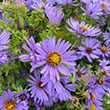
Height: 24 inches
Spread: 24 inches
Sunlight: full sun partial shade
Hardiness Zone: 4a
Other Names: Michaelmas Daisy
Description:
A mounded, bushy variety, perfect for adding color to fall gardens; beautiful sky blue daisy-like flowers with yellow centers are featured on green, fragrant foliage; easy to grow, requiring little to no maintenance; drought tolerant once established
Ornamental Features:
October Skies Aster has masses of beautiful sky blue daisy flowers with yellow eyes at the ends of the stems from early to late fall, which are most effective when planted in groupings. The flowers are excellent for cutting. Its narrow leaves remain dark green in color throughout the season.
Landscape Attributes:
October Skies Aster is a dense herbaceous perennial with a mounded form. Its relatively fine texture sets it apart from other garden plants with less refined foliage.
This is a relatively low maintenance plant, and is best cleaned up in early spring before it resumes active growth for the season. It is a good choice for attracting butterflies to your yard, but is not particularly attractive to deer who tend to leave it alone in favor of tastier treats. Gardeners should be aware of the following characteristic(s) that may warrant special consideration: Disease
October Skies Aster is recommended for the following landscape applications:
- Mass Planting
- General Garden Use
- Container Planting
Planting & Growing:
October Skies Aster will grow to be about 24 inches tall at maturity, with a spread of 24 inches. Its foliage tends to remain dense right to the ground, not requiring facer plants in front. It grows at a medium rate, and under ideal conditions can be expected to live for approximately 10 years. As an herbaceous perennial, this plant will usually die back to the crown each winter, and will regrow from the base each spring. Be careful not to disturb the crown in late winter when it may not be readily seen!
This plant does best in full sun to partial shade. It prefers to grow in average to moist conditions, and shouldn't be allowed to dry out. It is not particular as to soil type or pH. It is somewhat tolerant of urban pollution. This is a selection of a native North American species. It can be propagated by division; however, as a cultivated variety, be aware that it may be subject to certain restrictions or prohibitions on propagation.
October Skies Aster is a fine choice for the garden, but it is also a good selection for planting in outdoor pots and containers. It can be used either as 'filler' or as a 'thriller' in the 'spiller-thriller-filler' container combination, depending on the height and form of the other plants used in the container planting. It is even sizeable enough that it can be grown alone in a suitable container. Note that when growing plants in outdoor containers and baskets, they may require more frequent waterings than they would in the yard or garden.
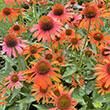
Tangerine blooms, Tolerates poor and dry soils, drought, and heat. USDA 5-9
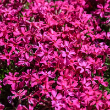
Height: 6 inches
Spacing: 15 inches
Sunlight: full sun, partial shade
Hardiness Zone: 2a
Other Names: Creeping Phlox
Ornamental Features:
Scarlet Flame Moss Phlox is smothered in stunning lightly-scented scarlet star-shaped flowers at the ends of the stems from early to late spring. Its tiny needle-like leaves remain green in color throughout the year.
Landscape Attributes:
Scarlet Flame Moss Phlox is a dense herbaceous evergreen perennial with a ground-hugging habit of growth. It brings an extremely fine and delicate texture to the garden composition and should be used to full effect.
This plant will require occasional maintenance and upkeep, and should only be pruned after flowering to avoid removing any of the current season's flowers. Deer don't particularly care for this plant and will usually leave it alone in favor of tastier treats. Gardeners should be aware of the following characteristic(s) that may warrant special consideration:
- Spreading
Scarlet Flame Moss Phlox is recommended for the following landscape applications:
- Mass Planting
- Rock/Alpine Gardens
- Border Edging
- General Garden Use
- Groundcover
Planting & Growing:
Scarlet Flame Moss Phlox will grow to be only 6 inches tall at maturity, with a spread of 18 inches. When grown in masses or used as a bedding plant, individual plants should be spaced approximately 15 inches apart. Its foliage tends to remain low and dense right to the ground. It grows at a medium rate, and under ideal conditions can be expected to live for approximately 10 years. As an evegreen perennial, this plant will typically keep its form and foliage year-round.
This plant does best in full sun to partial shade. It prefers dry to average moisture levels with very well-drained soil, and will often die in standing water. It is considered to be drought-tolerant, and thus makes an ideal choice for a low-water garden or xeriscape application. It is not particular as to soil type, but has a definite preference for alkaline soils. It is highly tolerant of urban pollution and will even thrive in inner city environments. Consider covering it with a thick layer of mulch in winter to protect it in exposed locations or colder microclimates. This is a selection of a native North American species. It can be propagated by division; however, as a cultivated variety, be aware that it may be subject to certain restrictions or prohibitions on propagation.
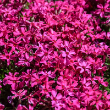
Vibrant reddish pink blooms. Evergreen. Groundcover. Native. USDA 2-9
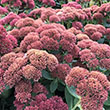
Height: 24 inches
Spacing: 18 inches
Sunlight: full sun, partial shade
Hardiness Zone: 2b
Other Names: Autumn Stonecrop, Showy Stonecrop
Description:
A highly desirable and popular groundcover, forming a dense mound completely covered in broccoli-like salmon-pink flowers which fade to red in early fall, succulent dusty-green foliage is prominent the rest of the season; needs a dry and sunny location
Ornamental Features:
Autumn Joy Stonecrop has masses of beautiful clusters of pink flowers at the ends of the stems from late summer to late fall, which emerge from distinctive coral-pink flower buds, and which are most effective when planted in groupings. The flowers are excellent for cutting. Its large succulent round leaves remain grayish green in color throughout the season.
Landscape Attributes:
Autumn Joy Stonecrop is a dense herbaceous perennial with an upright spreading habit of growth. Its relatively coarse texture can be used to stand it apart from other garden plants with finer foliage.
This is a relatively low maintenance plant, and is best cleaned up in early spring before it resumes active growth for the season. It is a good choice for attracting bees and butterflies to your yard, but is not particularly attractive to deer who tend to leave it alone in favor of tastier treats. It has no significant negative characteristics.
Autumn Joy Stonecrop is recommended for the following landscape applications:
- Mass Planting
- Border Edging
- General Garden Use
- Groundcover
- Container Planting
- Planting & Growing
Autumn Joy Stonecrop will grow to be about 20 inches tall at maturity, with a spread of 24 inches. When grown in masses or used as a bedding plant, individual plants should be spaced approximately 18 inches apart. It grows at a fast rate, and under ideal conditions can be expected to live for approximately 15 years. As an herbaceous perennial, this plant will usually die back to the crown each winter, and will regrow from the base each spring. Be careful not to disturb the crown in late winter when it may not be readily seen!
This plant does best in full sun to partial shade. It is very adaptable to both dry and moist growing conditions, but will not tolerate any standing water. It is considered to be drought-tolerant, and thus makes an ideal choice for a low-water garden or xeriscape application. It is not particular as to soil pH, but grows best in poor soils, and is able to handle environmental salt. It is highly tolerant of urban pollution and will even thrive in inner city environments. This particular variety is an interspecific hybrid. It can be propagated by division; however, as a cultivated variety, be aware that it may be subject to certain restrictions or prohibitions on propagation.
Autumn Joy Stonecrop is a fine choice for the garden, but it is also a good selection for planting in outdoor pots and containers. With its upright habit of growth, it is best suited for use as a 'thriller' in the 'spiller-thriller-filler' container combination; plant it near the center of the pot, surrounded by smaller plants and those that spill over the edges. Note that when growing plants in outdoor containers and baskets, they may require more frequent waterings than they would in the yard or garden.
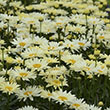
Height: 18 inches
Spacing: 18 inches
Sunlight: full sun, partial shade
Hardiness Zone: 4a
Group/Class: Amazing Daisies Collection
Brand: Proven Winners
Description:
An outstanding shasta daisy with large lemon blooms that mature to creamy white, with golden centers; vigorous, with an extra long bloom time, and disease resistant foliage; a beautiful addition to the garden when massed
Ornamental Features:
Amazing Daisies Banana Cream Shasta Daisy has masses of beautiful lemon yellow daisy flowers with gold eyes at the ends of the stems from early to late summer, which are most effective when planted in groupings. The flowers are excellent for cutting. Its serrated narrow leaves remain dark green in color throughout the season.
Landscape Attributes:
Amazing Daisies Banana Cream Shasta Daisy is an herbaceous perennial with an upright spreading habit of growth. Its medium texture blends into the garden, but can always be balanced by a couple of finer or coarser plants for an effective composition.
This plant will require occasional maintenance and upkeep, and should be cut back in late fall in preparation for winter. It is a good choice for attracting butterflies to your yard. Gardeners should be aware of the following characteristic(s) that may warrant special consideration:
- Insects
Amazing Daisies Banana Cream Shasta Daisy is recommended for the following landscape applications:
- Mass Planting
- Border Edging
- General Garden Use
- Container Planting
Planting & Growing:
Amazing Daisies Banana Cream Shasta Daisy will grow to be about 15 inches tall at maturity, with a spread of 24 inches. When grown in masses or used as a bedding plant, individual plants should be spaced approximately 18 inches apart. It grows at a fast rate, and under ideal conditions can be expected to live for approximately 5 years. As an herbaceous perennial, this plant will usually die back to the crown each winter, and will regrow from the base each spring. Be careful not to disturb the crown in late winter when it may not be readily seen!
This plant does best in full sun to partial shade. It does best in average to evenly moist conditions, but will not tolerate standing water. It is not particular as to soil type or pH. It is highly tolerant of urban pollution and will even thrive in inner city environments. This particular variety is an interspecific hybrid. It can be propagated by division; however, as a cultivated variety, be aware that it may be subject to certain restrictions or prohibitions on propagation.
Amazing Daisies Banana Cream Shasta Daisy is a fine choice for the garden, but it is also a good selection for planting in outdoor pots and containers. It is often used as a 'filler' in the 'spiller-thriller-filler' container combination, providing a mass of flowers against which the larger thriller plants stand out. Note that when growing plants in outdoor containers and baskets, they may require more frequent waterings than they would in the yard or garden.
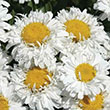
Large (2-4") daisy flower with white petals & a bright yellow center. Dark green foliage. USDA 4-9
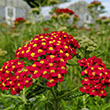
Cherry-red, gold centered flowers, later fading to light pink and creamy yellow. Spreading fern-like foliage. USDA 3-8
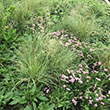
Clustered rose pink flowers that age to a soft creamy pink. Prefers well-drained soils. USDA 3-8

Ruffled petals with sunset pink and coral tones. Black walnut tolerant. USDA 3-9
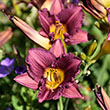
Ruffled purple blooms with yellow throats. Rebloomer. USDA 3-9
35 found, showing page 1 of 3















